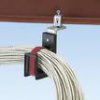IVB
Senior Member
My wiring sucks. It sucks bad. Well, it wouldn't have been so bad if I had stuck to my original plan of putting in 15-20 wires, but i'm at dozens and growing. This needs to be re-terminated so 1) i know what is what, and 2)I can call in an electrician to move some HV wires and he won't run.
Specifically, I need to rerun the last 10 feet of all my Elk wires, network, telephone, cable TV, camera, etc. The location has the Elk 2ndary cabinet, CQC/CCTV server, Sage server, telephone distro, router, D* box.
I have a patch panel (sitting in the box), a 28" Elk cabinet, a 12" leviton SMC & cabinet. I scored a spare 14" cabinet off someone, but it's damn well useless as it's so small. The location is only 5' high, so I can't put a full rack in there.
1) Is there any physical mounting hardware that you guys have found useful? I dunno what, mebbe stuff like wire guides? Anything that I should put inside the Elk cabinet to help with wire running?
2) For those of you who mounted your boards flat, how did you physically get them onto the can without resorting to that sticky foam that makes it a PITA to take the board out & back on? (or do you not worry about that)
I can only handle doing this one time; I really wish I didn't have to do this, but the organic growth of "oh, i can do this - but oh, i need more wiring!" is making the location just an unhappy place to be in. It's worse than my parents garage.
I'm willing to spend the, well, hopefully no more than dozens of dollars, to do this "right" so it's something that I could leave in place when I sell the house and not be embarassed about.
Any and all ideas appreciated.
Specifically, I need to rerun the last 10 feet of all my Elk wires, network, telephone, cable TV, camera, etc. The location has the Elk 2ndary cabinet, CQC/CCTV server, Sage server, telephone distro, router, D* box.
I have a patch panel (sitting in the box), a 28" Elk cabinet, a 12" leviton SMC & cabinet. I scored a spare 14" cabinet off someone, but it's damn well useless as it's so small. The location is only 5' high, so I can't put a full rack in there.
1) Is there any physical mounting hardware that you guys have found useful? I dunno what, mebbe stuff like wire guides? Anything that I should put inside the Elk cabinet to help with wire running?
2) For those of you who mounted your boards flat, how did you physically get them onto the can without resorting to that sticky foam that makes it a PITA to take the board out & back on? (or do you not worry about that)
I can only handle doing this one time; I really wish I didn't have to do this, but the organic growth of "oh, i can do this - but oh, i need more wiring!" is making the location just an unhappy place to be in. It's worse than my parents garage.
I'm willing to spend the, well, hopefully no more than dozens of dollars, to do this "right" so it's something that I could leave in place when I sell the house and not be embarassed about.
Any and all ideas appreciated.









